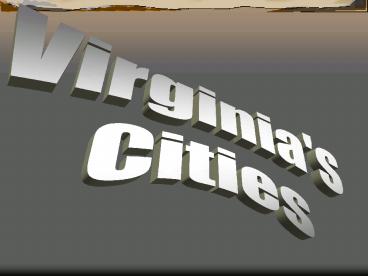Virginia's - PowerPoint PPT Presentation
1 / 42
Title:
Virginia's
Description:
Cities developed along the Atlantic Ocean, the Chesapeake Bay, and the major rivers in Virginia. ... around the mouth of the Chesapeake Bay was Yorktown. ... – PowerPoint PPT presentation
Number of Views:17
Avg rating:3.0/5.0
Title: Virginia's
1
Virginia's Cities
2
How did the geographic factors of Virginia affect
the growth and location of its cities?
3
All the areas shown in red are cities in Virginia.
How did land and water forms make cities grow?
4
Cities developed along the Atlantic Ocean, the
Chesapeake Bay, and the major rivers in Virginia.
5
Virginias earliest cities grew here, near the
Chesapeake Bay and the Atlantic Ocean.
6
Why did cities develop along the Atlantic Ocean?
7
Cities developed in areas of Virginia that had
access to the Atlantic Ocean, because goods could
be shipped from there.
8
At first, ships had only sail power.
9
Today, freighters are powered by oil, but they
still load on the docks of Virginias cities.
10
Cities developed around the mouth of the
Chesapeake Bay, where the Bay meets the Atlantic
Ocean.
Mouth of the Chesapeake Bay
11
Cities developed around the mouth of the
Chesapeake Bay because of its rich natural
resources and its natural harbor.
12
Cities developed around the mouth of the
Chesapeake Bay because of its rich natural
resources.
13
Cities developed around the mouth of the
Chesapeake Bay because of its natural harbor.
14
A city that developed around the mouth of the
Chesapeake Bay was Norfolk. It had rich natural
resources and a natural harbor.
15
Another city that developed around the mouth of
the Chesapeake Bay was Hampton. It had rich
natural resources and a natural harbor.
16
A third city that developed around the mouth of
the Chesapeake Bay was Yorktown. It had rich
natural resources and a natural harbor.
17
Cities also developed along the Fall Line,
because it was a natural barrier to river
transportation.
18
The Fall Line is where the waterfalls begin.
19
Waterfalls are found where the land is hilly.
20
Because of the waterfalls, and rocks in the
river, it is too dangerous for big boats to go
inland, away from the ocean, past the Fall Line.
21
So big ships had to stop at the Fall Line and
unload.
22
Businesses developed in places where the big
ships unloaded.
23
There were good jobs loading and unloading large
ships.
24
People bought goods headed in both directions and
sold them to people who took them to their
destinations.
25
One city that developed at the Fall Line is
Richmond.
26
Richmond is at the Fall Line on the James River.
27
Cities also developed along rivers.
28
Cities developed along rivers because rivers were
the main transportation routes in early Virginia.
29
Cities needed to be near rivers so people could
send their crops down the river to market.
30
A city that developed along the Potomac River is
Alexandria.
31
Cities developed in the Shenandoah Valley.
32
In the Shenandoah Valley, cities developed
because of its rich soil.
33
In the Shenandoah Valley, cities developed
because of the natural shelter of the mountains.
34
The mountains gave the cities shelter from strong
wind and bad weather.
35
In the rich soil of the Shenandoah Valley, German
and Scots-Irish settlers could grow more than
they needed for their families.
36
The protection of the mountains gave them better
weather for better and bigger crops.
37
They sold their big crops for cash. Cities
became places for them to sell crops and buy
things for their families.
38
Other people bought the crops in the cities of
the Shenandoah Valley, and distributed them to
still other people. So the cities grew.
39
Harrisonburg is a city in the Shenandoah Valley
that grew because of the rich soil and the
natural shelter of the mountains.
40
Winchester is another city in the Shenandoah
Valley that grew up because of the rich soil and
the natural shelter of the mountains.
Bridgewater College, where Mrs. Flora went to
college, is in Winchester.
41
So we see that cities developed, or grew, all
over Virginia.
Our city, Danville
42
And geography, or land and water, had a big
effect on where the cities grew.
May you grow up straight and strong. Mrs. Wooding































